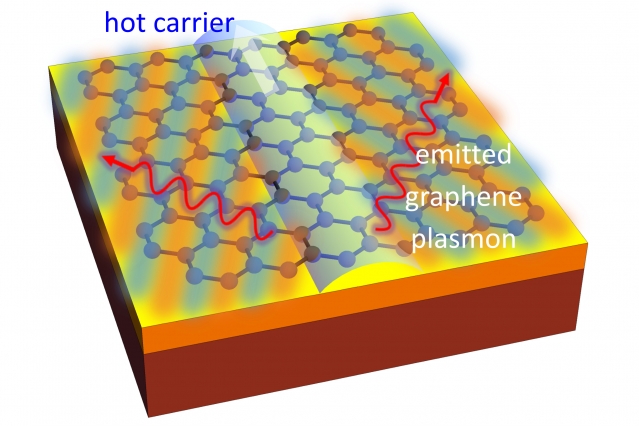
MIT figures out how to turn electricity into light using graphene
Researchers from MIT have created an optical “sonic boom” by slowing down light to a speed slower than flowing electrons.
When an airplane starts moving faster than the speed of sound, it creates a shockwave that produces a “boom” of sound (“sonic boom”). Now, researchers from MIT have discovered that something similar happens in a sheet of graphene. In a sheet of graphene, under certain circumstances, a flow of electric current can exceed the speed of slowed-down light and produce the same kind of optical “boom,” resulting in an intense, focused beam of light.
The team found that this new way of converting electricity into visible radiation is controllable, fast, and efficient, and could even result in a variety of new applications.

The team stumbled upon this finding after observing that when light strikes a sheet of graphene, which is a two-dimensional form of the element carbon, it can slow down by a factor of a few hundred. That dramatic slowdown coincidentally reduced the light particles moving through the sheet of graphene, very close to the speed of electrons as they moved through the same material.
“Graphene has this ability to trap light, in modes we call surface plasmons,” said Ido Kaminer, MIT postdoctoral student, who is the paper’s lead author. Plasmons are a kind of virtual particle that represents the oscillations of electrons on the surface. The speed of these plasmons through the graphene is “a few hundred times slower than light in free space.”
This effect dovetailed with another of graphene’s exceptional characteristics: Electrons pass through it at very high speeds, up to a million meters per second, or about 1/300 the speed of light in a vacuum. That meant that the two speeds were similar enough that significant interactions might occur between the two kinds of particles, if the material could be tuned to get the velocities to match.
Slowing down light while allowing electrons to move very fast was seen as a very unusual property of graphene, according to the researchers. To the team, this suggested the possibility of using graphene to produce the opposite effect: to produce light instead of trapping it.
“Our theoretical work shows that this can lead to a new way of generating light,” said Marin Soljačić, professor of physics at MIT. “This conversion is made possible because the electronic speed can approach the light speed in graphene, breaking the ‘light barrier.’” Just as breaking the sound barrier generates a shockwave of sound, he says, “In the case of graphene, this leads to the emission of a shockwave of light, trapped in two dimensions.”
The team harnessed a phenomenon called the Čerenkov effect, which was described 80 years ago by physicist Pavel Čerenkov and is usually associated with astronomical phenomenon as a way of detecting ultrafast cosmic particles as they travel through the universe.
The effect had not been considered in Earth-related technology because it only worked when objects move close to the speed of light, but the slowing of light inside a graphene sheet provided the opportunity to harness this effect in a practical form, the researchers say.
While there are plenty of ways to create light, this new plasmon-based approach might eventually be part of more efficient, more compact, faster, and more tunable alternatives for certain applications, according to the researchers.
Additionally, this is a way of generating plasmons on a scale compatible with current microchip technology. Graphene-based systems like this could potentially be key on-chip components for the creation of new, light-based circuits, which are considered a new direction in the evolution of computing technology toward smaller devices.
“If you want to do all sorts of signal processing problems on a chip, you want to have a very fast signal, and also to be able to work on very small scales,”said Kaminer. Computer chips have already reduced the scale of electronics to the points that the technology is bumping into some fundamental physical limits, so “you need to go into a different regime of electromagnetism.”
The new method has the potential to push the operating speeds “six orders of magnitude higher than what is used in electronics,” according to Kaminer. In principle, that’s up to a million times faster.
At this time, the work is theoretical, but next steps will include creating working versions of the system to prove the concept.
“I have confidence that it should be doable within one to two years,” said Kaminer. The next step would then be to optimize the system for the greatest efficiency.

Comments are closed, but trackbacks and pingbacks are open.